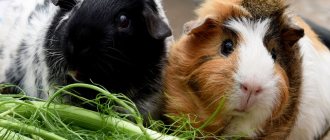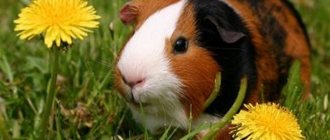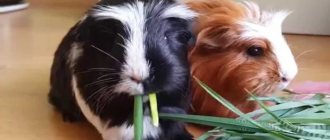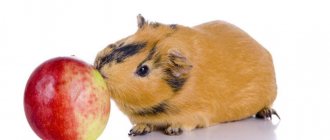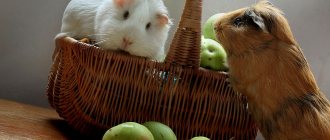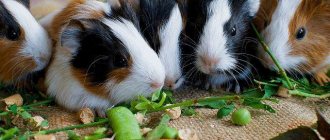Add vitamin C to your animal's diet. The well-being of guinea pigs depends on a number of conditions. Proper nutrition is the most important of them. The products included in the animals' diet provide them with nutrients and beneficial substances. Vitamin C, which is found in citrus fruits, is very important for guinea pigs.
With its deficiency, animals' metabolism is disrupted, immune defense is reduced and even high-calorie feeds are poorly absorbed.
However, not all rodents show interest in citrus fruits, although some enjoy eating these fruits.
Why can't hamsters eat citrus fruits?
During the cold season, the choice of fresh fruit is limited, so hamster owners can try feeding them oranges or tangerines.
Bright orange fruits charge a person with energy and vitamins, but are not at all suitable for feeding a furry friend. Citrus fruits contain too much citric acid and sugar, which are harmful to the baby's digestive system. Reasons for the ban:
- Citric acid destroys tooth enamel, which is not present on the inside of a hamster's tooth;
- Too acidic foods irritate the mucous membrane of the stomach and intestines, and they are very sensitive. Poor nutrition is one of the main causes of diarrhea in rodents;
- Citrus fruits contain a high dose of vitamin C for hamsters, which can lead to disruption of the body’s functioning and hypervitaminosis;
- Excess sugar in citrus fruits causes diabetes, to which small rodents are prone;
- Oranges and tangerines are allergenic foods not only for people, but also for hamsters.
If you treat your pet to citrus fruits, health problems may occur:
- Hair loss and baldness are the result of allergies and excess vitamin C;
- Watery stools, diarrhea due to intestinal irritation;
- Swollen belly.
When eating unsuitable food, the animal's behavior changes. There is no trace left of the former active and cheerful hamster. He becomes lethargic, apathetic, his fur is disheveled. A sick animal begins to behave aggressively and bite.
If your pet develops these symptoms, it should be taken to a veterinarian immediately. The peculiarity of hamsters is that all processes occur in the body at high speed and cause death.
Results
In conclusion, I would like to say that not everything that your guinea pig eats will be good for it. Do not try exotic products on her. If you don’t know whether your guinea pig can eat this or that product, it’s better not to feed it. A rodent in captivity cannot distinguish between products that are not healthy for it and therefore will eat everything you offer. On forums you can often see messages that some owners' guinea pigs eat almost all the foods on the prohibited list. But do not experiment on your pet; give him only vegetables, grass, herbs and fruits growing in our country. Believe me, without oranges, tangerines, bananas, kiwis and other harmful fruits, they will survive and live a long and happy pig life, delighting you.
« Previous entry
Citrus fruits are a rare treat
Pet nutrition can be divided into main food and treats. It is as a treat that the animal can receive a small piece of tangerine or orange. But there are some restrictions. If the female is at the stage of feeding babies, then eating citrus fruits is prohibited.
The product is also excluded for the following problems:
- any allergic reactions;
- skin and coat problems;
- gastrointestinal disorders.
If there are any problems in the animal’s body, you should not give citrus fruits. If you have not yet offered your pet to eat unfamiliar fruits, then you should not do this during any move; in any case, it will be stressful. It is unknown how the rodent will react.
Young pigs should not be fed citrus fruits - this can only be done after the pet has switched to adult food and the digestive organs have adapted to different foods.
If after the animal has tasted the treat and has diarrhea, you can make a light decoction of chamomile. The product normalizes digestion and helps get rid of diarrhea.
Possible problems
Animals, like people, can suffer from overeating. The stomach is not always able to process excess amounts of food, which negatively affects the pet’s condition. And excessive consumption of sweets does not have the best effect on health.
Do not forget that the Product given to the rodent must be of high quality. This will protect your pet from poisoning and diarrhea. In addition, banana is considered an astringent product.
An excessive amount of such treats will not allow the animal to go to the toilet in a timely manner. And irregular bowel movements and retained excrement in the body have a negative impact.
Overeating and poor-quality products harm the animal
It is important to remember that it is important to approach your pet’s nutrition as responsibly as you do your own.
In what cases should you not give
Citrus fruits are atypical foods for pigs and cause a sensitizing load on the body. Therefore, they are contraindicated for digestive problems. At the same time, tangerines are quite allergic fruits; if your pet already has a tendency to such diseases or skin lesions, then they cannot be included in the diet. For the same reason, there are contraindications for young animals. They should not consume citrus fruits until their digestive system is fully formed.
Pigs are prone to stress, new food is also one of the factors. Therefore, if the animal has never eaten tangerines before, and has an exciting situation in its life (moving to a new house, walking on the street, meeting another animal), then you should not try to appease it with such a treat. This will only worsen his condition.
During pregnancy and breastfeeding, citrus fruits are contraindicated for females.
Bottle with drinker
Such an accessory will come in handy during street walks. It does not take up much space, weighs little and does not hinder movement. But you can offer the dog to quench his thirst at any time, and not wait until he starts drinking from a dirty puddle or lake overgrown with mud.
The device consists of a water container and a bowl equipped with a dispenser button. It allows you to release as much liquid from the bottle as the animal needs to quench its thirst. Sold in two volume options - 350 and 550 milliliters.
Price – 475 – 584 rub.
Another model of the same device has a folding shape, which makes it easier to carry. The transformer connects the bowl and the bottle, securely fixing them in such a compact state. The durable polymer material has good shockproof properties and can even resist dog teeth. True, this struggle will not be long and - if the owner is careless - then all the liquid will end up on the ground.
Volume 250 ml.
Cost – 133 – 148 rubles.
I like1I don't like
Fruits and berries
Bananas
Can guinea pigs have bananas? A banana rich in potassium will benefit your guinea pig, but you should not give more than 1 piece per day.
The peel of the vegetable must be removed, as it is treated with substances hazardous to health (wax, chemicals, ethylene and pesticides). For safety, it is better to remove soft fibers from the fruit.
Can guinea pigs eat a pear?
Pears can be given with the peel, but without the seeds. The fruit is washed well and cut into pieces; the pig should be offered water along with it. Excessive consumption of pears due to their high sugar content can cause diarrhea.
Can guinea pigs eat kiwi?
Kiwi is a very healthy fruit for animals. It contains a large amount of ascorbic and folic acids. It is also rich in vitamins E, iron, calcium, magnesium and phosphorus.
Kiwi is given without skin in the form of small pieces. For your pet, you need to choose harder fruits. It is better to control the amount you eat. An increase in the dose of kiwi is permissible in autumn and winter, as well as when feeding females during pregnancy and lactation.
Can guinea pigs have oranges and other citrus fruits?
Can be used occasionally. But it is better for guinea pigs to get vitamin C from other foods, avoiding citrus fruits. Possible complications:
- oversaturation with vitamins;
- skin irritation;
- oxidation of urine.
Can guinea pigs eat apples?
Apples can be raw or dried. They have a balanced ratio of sugar and fructose (18:80%). It allows the pig to be active.
The fruit must be peeled and cut into slices. It is better not to give more than 3 pieces at a time.
Can guinea pigs eat strawberries, grapes and other berries?
Strawberries contain a sufficient amount of vitamin C to pay attention to the berry when choosing a treat for a rodent. You can also give strawberry leaves to animals.
- The pig might like grapes. You can offer the animal seedless grapes.
- Eating currants once a week will also not harm your pet.
- If you do not abuse it, you can offer the pig berries and raspberry leaves, berries, leaves and branches of blueberries, blackberries and sea buckthorn, and rose hips without seeds.
- Cranberries are given for medicinal purposes. It has an anti-inflammatory effect on the mucous membranes of the mouth, stomach, and bladder.
Necessary for care
Like any other pet, a guinea pig requires a wide variety of grooming accessories. These include:
- cage or aquarium;
- feeder;
- sippy cup;
- house;
- filler;
- mineral stone;
- toys;
- carrying;
- hygiene products;
- brush-comb and nail clipper.
Cage or aquarium
Keeping a guinea pig is allowed both in an aquarium and in a cage. The main condition is size: the dwelling must be at least 50 cm in length and 30 cm in height so that the animal can move comfortably. If you have decided on a cage, then it is best to take a closer look at the options that have a plastic bottom. Plastic is quite easy to care for, it is easy to wash, dry, etc. A wooden base is not suitable due to the fact that these animals drink a lot of liquid per day, and therefore excrete a large amount of urine. The wood will simply become unusable in a very short time. You can purchase an aquarium in the above sizes. It, like a cage with a plastic bottom, is easy to wash and clean. But you should be careful, since glass is a very fragile material and when moving it, for example, to another room, you should follow safety rules (the pet should not be in the aquarium, it should be transferred to a carrier).
cell
Feeder
The feeder should be heavy enough so that the guinea pig cannot knock it over. An excellent option would be bowls made of ceramics, stainless steel, etc. It is also recommended to buy 2-3 containers. For example, one will be used for vegetables or fruits, and the second for dry food.
Sippy cup
A vertical ball sippy cup is perfect for a guinea pig. It is usually made of plastic with a metal tip. In such a drinking bowl there is no need to change the water daily, but this is done about 2-3 times a week.
House
Be sure to install a small house in the cage or aquarium. Your pet will sleep in it, relax, or simply retire when he wants to be alone. Most often, such houses are made of wood with a round “door” cut out in the middle. The most optimal size is 25 cm in length and 15 cm in height. This space is enough for the animal to hide and at the same time feel comfortable.
house
Filler
When arranging the cage, do not forget about the bedding. It will create comfort in the cage, prevent the animal from freezing and, to some extent, maintain cleanliness. You can use sawdust or ground corn cobs as a filler. Under no circumstances put cotton wool, newspaper, paper, etc. in the cage as bedding, as this is not safe for your pet’s health.
Mineral stone
To maintain dental health and calcium levels in your guinea pig's body, mineral stone is essential. After all, it serves not only as a vitamin complex, but also perfectly helps the animal grind its teeth. This stone is sold in a pet store, and its price is quite affordable.
stone
Toys
Guinea pigs are somewhat similar in behavior to decorative rabbits. They love to play. Therefore, be sure to buy some interesting and funny toy for your pet, for example, a tunnel, a hammock, a mirror, a rolling wheel, etc. The game will not only bring joy and pleasure to the animal, but will also strengthen muscles, and will also be an excellent preventive measure against obesity.
Carrying
If your plans did not include traveling together or any trips with your guinea pig, then you will still need a carrier. Transporting an animal in your arms, in a box or blanket is strictly prohibited. For example, you need to visit a veterinarian or transport the animal to another house or apartment; in such life situations, a carrier will definitely help you out. The pig will feel safe and the transportation process will go smoothly.
Hygiene products
Guinea pigs are considered clean animals, but sometimes they are still allowed to be bathed. For such cases, it is necessary to use special hygiene products that can be purchased at a pet store. The most popular of them:
- “Biogance” – bio-perfume;
- “Veda” – wheat shampoo.
Brush-comb and nail clipper
Caring for your guinea pig's coat and claws is extremely important. To do this, you need to purchase a special comb with soft bristles (combing is done daily), as well as a nail clipper for trimming the claws (the procedure is performed as they lengthen).
Nutrition for pregnant pigs and newborn piglets
Pregnant pets must eat well and of high quality. The diet of furry mothers should be rich in proteins and vitamins. It is useful to give pregnant females carrots, beets, and wheat sprouts. You can periodically add a little milk to the water. Rosehip infusion brings great benefits to the body of a pregnant pig.
If the female who gave birth does not have milk, then the owner will have to feed the cubs on his own using a syringe. Artificial food for small piglets includes low-fat cream and the probiotic Linex. The cream is taken into the syringe and a tenth of the probiotic capsule is added to it. The resulting solution is nutritious and beneficial for the digestive system of babies. The food in the syringe is warmed to room temperature. Piglets take 1 ml of food every hour. Two-week-old babies can be switched to cereal porridge without milk. The piglets sit on the porridge until they get used to “adult” food.
Pear for a guinea pig: is it possible or not?
The ancient expression “hunger is not an aunt” is relevant not only in the human environment. As for our smaller brothers, this is perhaps doubly true. Take a guinea pig: if it remains hungry even for a very short time, it can be dangerous for its health.
Therefore, future owners of these domesticated rodents are always warned: the pet’s feeder should not be empty! If an animal doesn’t eat its ration right away, it will certainly eat it later; it doesn’t suffer from a lack of appetite and absorbs whatever you give it.
And in between feedings, he will chew something - for example, hay, which is necessary both for grinding down teeth and for improving the digestive process.
Poisonous plants
When going to collect herbs for your beloved pet, you need to remember that there are a number of poisonous plants that not only cause poisoning, but also lead to death.
Plants that are poisonous and dangerous to guinea pigs include:
- Fighter,
- Arum,
- white acacia,
- Common aloe
- Common and lemon geraniums,
- All types of ferns,
- All types of lilies,
- Sorrel,
- Nightshade,
- Henbane,
- Lilies of the valley,
- All varieties of narcissus,
- Hyacinths,
- Celandine.
The following are considered dangerous for animals:
- Bay leaf,
- Gorse,
- All types of wisteria,
- Yew,
- All varieties of ivy,
- Deren,
- Common broom,
- Dogwood and all varieties of honeysuckle.
It is strictly forbidden to feed the following tree species:
- Thuja and oleander sprigs,
- Biryuchina,
- Juniper shoots and roots,
- Berries, leaves and twigs of elderberry,
- mistletoe,
- Leaves, shoots and twigs of hellebore and belladonna.
Oranges and tangerines
Citrus fruits are contraindicated for guinea pigs due to their high content of fruit acids.
Fruit acids irritate the skin and acidify urine. But guinea pigs are fed citrus pulp and peels treated with chemicals and rich in essential oils, which should not be done under any circumstances. When eating oranges, tangerines and other citrus fruits, your pet may experience cheilitis, or even death. And guinea pigs will eat whatever you give them.
Cherries, sweet cherries, apricots, peach, plums and other stone fruits contain large amounts of sugar and when feeding a large amount of them along with water to your pet, severe diarrhea occurs. If you want to feed your guinea pig cherries, apricots or other similar fruits, first remove the pit and offer the pig half a cherry or a tiny piece of apricot to start with. If the rodent reacts normally to this fruit, you can gradually increase the amount.
Under no circumstances should you give cherry, sweet cherry, apricot, peach, or plum pits, because they contain hydrocyanic acid.
It is not advisable to give exotic fruits - guava, lychee, mango, papaya, pineapple and others, as they can cause dangerous digestive upset. Some fruits, such as avocados, are toxic to rodents and cause diarrhea.
cucumbers
Most often, owners are interested in whether guinea pigs can eat cucumbers. These vegetables contain 2-6% dry matter - sugars, fiber, protein, some vitamins and microelements. 94-98% of the total mass of a cucumber is water, so this vegetable has little nutritional value. But, despite this, cucumber helps the rodent’s body digest other foods and absorb fats. You can give cucumbers to guinea pigs in small quantities and, preferably, your own, since poisoning often occurs due to the nitrates contained in purchased cucumbers. Overfeeding cucumbers can lead to digestive problems.
Is it possible to give citrus fruits?
Unlike exotic fruits, citrus fruits do not contain toxins that could harm your dog's health. They are not dangerous when used in small quantities. Sour fruits contain vitamins and minerals necessary to improve metabolism and the functioning of internal organs in the animal’s body.
The ASPCA, a pet protection society, has conducted a number of studies. In the process of studying citrus fruits, it was revealed that the peel, seeds and pulp of the fruit contain different amounts of citric acid. This organic compound irritates the mucous membranes of the dog's gastrointestinal tract and depresses the central nervous system in large quantities. At the same time, to receive such harm, the dog will have to eat about 7-10 tangerines or 5 large oranges.
Veterinarians claim that when eating half a citrus fruit, the dog does not experience indigestion. Small breeds may experience stomach problems after using several tangerines. This phenomenon is due to the small size of the animal. His body cannot cope with the processing of sucrose and citric acid.
Citrus fruits have several benefits that make them a good choice to include in your pet's diet:
- the fruits do not contain harmful or toxic substances and are not treated with insecticides;
- fruit juice and pulp contain flavonoids, organic acids, vitamins and minerals necessary for the normal functioning of the animal’s internal organs and systems;
- thanks to the large amount of ascorbic acid, the dog’s immunity is strengthened and resistance to infectious diseases increases;
- nutrients increase muscle tone and increase the pet’s physical activity.
At the same time, some veterinarians believe that citrus fruits should be excluded from the dog’s diet or given fruit in limited quantities. The negative attitude of specialists is due to the following factors.
- In the wild, other canid predators do not eat citrus fruits, so dogs can live without oranges, lemons or tangerines in their diet.
- The high content of bioactive compounds and organic acids provokes the development of allergic reactions and increases the acidity of gastric juice. Because of this, vomiting, diarrhea, and gastritis may occur.
- If a dog loves tangerines or oranges because of their sweet taste, he will begin to beg for treats or steal them from the table. Overuse of herbal products can place a heavy burden on the liver and kidneys.
To avoid unpleasant consequences, you should consult a veterinarian before including citrus fruits in your pet’s diet. The specialist will give an opinion on the pet’s health and, if necessary, conduct allergy tests.
Vintage basket
Here we are dealing with a representative design in the style of modern rural fashion. Best suited for lovers of cycling or short distance travel on scooters. The basket itself is woven from flexible willow and equipped with an openwork wire lid, which prevents the cat from wanting to get out while moving. At the first glance at such a carrier, one is reminded of idyllic pictures from centuries ago, when food from the market was transported in a similar way on bicycles. The entire structure is conveniently attached to the steering wheel using leather straps and does not require much time for preparation.
The advantage of the option under consideration is, of course, its original design and originality. The downside is limited functionality. Although, if desired, the basket can be used for its intended purpose.
Price – 1,128 – 1,708 rubles.
Rules for adding branches to a guinea pig's diet
There is no need to give your animal dry branches. The pig needs the micronutrients and macronutrients of a fresh tree, so pick twigs from a healthy, fruit-bearing tree. By eating twigs, the animal will stimulate the gums and improve blood circulation throughout the body.
What branches can you choose without harming your pet’s health?
The guinea pig has an absolute intolerance to essential oils - it can easily become poisoned by consuming them. Cyanide glucosides also contribute to animal poisoning. Therefore, there is a clear list of trees whose branches are strictly prohibited for a guinea pig to take as food.
These include:
- Apricot, cherry, plum, peach and other trees are fragrant fruit-bearing trees with a seed in the fruit;
- Spruce branches and branches of other coniferous plants;
- Lemon, tangerine, orange and other trees are branches of any citrus tree.
- Buckthorn is strictly prohibited. Contains poisons;
- Robinia - similar.
The list of trees whose branches can be eaten by guinea pigs is much longer than the list of forbidden plants.
These include:
- Poplar - twigs are possible in limited quantities;
- Quince - twigs are allowed, but the fruit itself is prohibited;
- Willow - twigs are allowed to be consumed in limited quantities - contains tannic acid;
- Elm - can be used in limited quantities and often. If you eat a lot, it contributes to constipation.
- Walnut - twigs are allowed to be consumed in limited quantities - walnut leaves are also allowed, but the nuts themselves are prohibited;
- Oak - possible in limited quantities - contains tannins. Acorns should not be given to rodents - they are poisonous;
- Maple - possible in unlimited quantities;
- Branches of apple, pear, hazel - in unlimited quantities;
- Hawthorn - twigs are allowed to be consumed in unlimited quantities. Be sure to remove the thorns from the branches, otherwise the animal runs the risk of getting hurt;
- Gooseberries - twigs are allowed to be consumed in unlimited quantities, after removing the thorns;
- Currants - possible in unlimited quantities;
- Blueberries - in unlimited quantities;
- Alder - twigs are allowed to be consumed in unlimited quantities;
- Ash - possible in limited quantities. Berries and buds are prohibited!
- Linden - available in limited quantities. Has a diuretic effect;
- Birch - try to use less often and in limited quantities. Contains tannic acid;
- Beech - twigs are allowed to be consumed in limited quantities;
- Chestnut - can be used extremely rarely and in small quantities. Consuming more can cause your guinea pig to develop a disease such as paralysis. Chestnuts themselves are generally prohibited from giving;
- Rowan - can be used rarely and in limited quantities.
The twig should be given to the guinea pig raw, untreated. You can wash it first. If there are thorns on the plant, remove them.
It doesn’t matter at all which branches you choose. It is important that your guinea pig always has some twigs on hand.
With them she will stimulate her gums, and will also be able to eat, receiving useful microelements and vitamins.
Should you give your guinea pig leaves?
For the guinea pig, the leaves are a kind of treat. Therefore, of course, they should be present in the daily summer diet of a rodent.
Along with the leaves, the pig will eat plant twigs.
Which leaves are the healthiest for guinea pigs:
- birch;
- linden;
- maple;
- willow
These leaves can be consumed in any quantity, even around the clock. The pig will only get better from such a diet.
For the winter, you can stock up on healthy, nutritious leaves and twigs so that your pig has an excellent, balanced diet all year round.
Grain feed
A guinea pig needs to eat at least 20% grain per day. Grain food for rodents is sold in any pet store. The finished product usually includes:
- barley;
- oats;
- millet;
- sunflower seeds;
- corn grains.
In addition to grain, prepared feeds may include vegetable granules and vitamin supplements.
Dry pet food is easy to prepare yourself; you just need to buy different types of grains on the market and then mix them. But you need to take into account that the main ingredient is oats; guinea pigs eat it more readily than other grains. Solid grain food should always be present in the diet of rodents. Animals need it to grind down their continuously growing teeth. If a rodent eats only raw and soft food, then its incisors become unnaturally elongated and interfere with the ability to absorb food. As a result, the animal dies from starvation.
What are the benefits of citrus fruits?
Tangerines, oranges and lemons are rich in vitamin C - even a child knows this. Vitamin C, or ascorbic acid, is a biologically active water-soluble organic compound that has many beneficial properties and is a necessary element that is involved in many processes occurring in the body of both humans and animals.
The main beneficial property is considered to be the vitamin’s positive effect on the immune system, improving its protection against bacteria and viruses, which is why during the cold season doctors recommend eating more citrus fruits to boost immunity. After all, it is during this period that the danger of colds and viral diseases increases, from which pets are not immune.
In addition, vitamin C:
- regulates hematopoietic processes;
- improves capillary permeability;
- participates in the synthesis of certain hormones and proteins;
- regulates metabolism;
- has a positive effect on the nervous system, protecting the body from the negative consequences of stress factors;
- helps accelerate the removal of toxins from the body;
- accelerates wound healing; restores the functions of the thyroid and pancreas;
- improves bile secretion, etc.
Scientists see a direct connection between sufficient vitamin C in the body and a reduced risk of cancer. Ascorbic acid is necessary to increase the stability of B vitamins, as well as A, E. For better absorption of vitamin C, the body also needs magnesium and calcium.
But not only this vitamin is found in tangerines. They are rich in other useful substances. Citrus fruits also contain:
- vitamin A – improves vision, improves the condition of the skin and mucous membranes;
- vitamin B1 – has a beneficial effect on the nervous system of the body;
- vitamin D – improves the functioning of the cardiovascular system and brain;
- vitamin K – helps strengthen the walls of blood vessels;
- microelements - magnesium, sodium, potassium, iron, calcium, phosphorus and others.
Tangerines contain phytoncides - these are natural antiseptics, which
Knowing all the beneficial properties of orange fruits, many pet owners safely give them to their pets. What do veterinarians think about this?
Green feed
This food for guinea pigs is the most healthy and natural. Your pet should eat fresh greens, rich in fiber and nutrients, to maintain normal functioning of the intestinal tract. Below is a list of herbs recommended for guinea pigs:
- cereal sprouts;
- spinach;
- lettuce leaves;
- clover;
- carrot tops;
- beet tops;
- dill, parsley, cilantro;
- plantain;
- yarrow;
- chamomile;
- dandelion leaves.
You need to be very careful when collecting grass for your pet. Among the useful plants there may be poisonous ones. Therefore, you should not put a bunch of grass in a cage without carefully sorting it out first. Fresh greens for your guinea pig should be thoroughly washed.
The benefits of raspberries for a pet
It is simply impossible to resist ripe, juicy, aromatic and sweet raspberries. In addition to being one of the most delicious berries, it is also very healthy. It contains anti-inflammatory substances and antioxidants that the body needs.
So, in order to understand whether an animal needs raspberries and what benefits they can bring, you should understand the characteristics of the body and the substances contained in the product.
The body of guinea pigs cannot independently produce such a vital and necessary element for health as vitamin C. Therefore, it must be given to the animal additionally. The daily diet should contain the daily requirement of vitamin C, which is 10-30 mg.
Studies have been conducted that have shown that insufficient intake of vitamin C in pets increases the risk of developing cardiovascular diseases. This element is also required by the body to regulate the level of copper and iron in the animal’s blood.
In addition to vitamin C, raspberries also contain other beneficial substances, such as fiber, which contributes to the correct and complete processes of the digestive tract.
100 g of berries contain 1.2 g of proteins and 11.9 g of carbohydrates. Animals that are overweight need to reduce their intake of carbohydrates.
Let's take a closer look at what substances raspberries are rich in and what is the concentration of nutrients in 100 g of this product:
- Cellulose. Promotes good digestion, in addition, it is required to avoid constipation. But it is also worth considering that an excess of fiber will also not bring anything good, since it can lead to loose stools and gas. Contains 6.5 g fiber.
- Sugar (4.4g). A large amount of sugar will not benefit anyone; this substance leads to obesity, disruption of digestive processes, and causes spasms. But in small quantities when contained in fruits and berries, it is acceptable.
- Vitamin A (1%). It acts as a powerful antioxidant, is an ideal preventative against inflammation, and also cleanses the body of free radicals.
- Vitamin E (4%). It is necessary for the health of the cardiovascular system, vision organs, skin, and also prevents cancer.
- Vitamin B6. This substance normalizes sleep and emotional state, relieves stress, and promotes the production of serotonin, which is called the hormone of happiness.
- Pantothenic acid (3%). This is vitamin B5 necessary for the body, with the help of which all food products are processed into energy.
- Iron (4%). If the amount of this substance is insufficient, the risk of developing anemia increases.
- Magnesium (5%). Prevents the development of diabetes, is necessary for health and full development of muscle tissue.
- Potassium (4%). Ensures the health of the cardiovascular system and helps normalize blood pressure.
Vegetable menu
Pigs have to look for vitamin C, which is responsible for the functioning of connective and bone tissues, from the outside, since their body is not able to produce it on its own.
Guinea pigs love apples, cucumbers and carrots.
Ascorbic acid enters the body from plant foods, including fresh vegetables (broccoli, bell pepper), amounting to at least 1 teaspoon per day.
Vegetables that can be given to guinea pigs include:
- Zucchini
. Rich in vitamins, minerals and pectins, which normalize intestinal motility. - Carrot
. Positively affects the condition of the skin and coat, visual and auditory functions. In addition to root vegetables, it is allowed to feed tops. The beta-keratin (vitamin A) content gives urine an orange tint. - Bell pepper
. Rich in vitamin C, but dangerous in winter due to the amount of harmful nitrates. Only sweet varieties are allowed as food, while spicy ones lead to irritation of the mucous membranes. - Pumpkin
. Not only the pulp is eaten, but also the crust and seeds, which are rich in zinc and act as a prophylactic against helminthiases. - Cucumbers
. Low in calories, have an anti-inflammatory effect and facilitate the absorption of fats. Not suitable as a main food and dangerous in winter (high nitrate content). - Fresh peas
. It is recommended to feed your pets only fresh pods, without overusing the quantity. Dried grains should not be consumed, but some manufacturers add them to ready-made food. - Cabbage
. Requires competent control. It is introduced gradually to avoid excessive gas formation. Rich in sulfur, which synthesizes collagen and adds shine to the coat. - Rutabaga
. Helps with constipation, facilitating peristalsis, and has a diuretic effect. Recommended for use in winter, when the choice of vegetables becomes limited. - Jerusalem artichoke
. The consumption of root vegetables enriched with starches should be limited to avoid intestinal disorders. The remaining parts, rich in fiber and amino acids, are allowed on an ongoing basis.
Controversial and dangerous vegetables include:
- Tomatoes
. In their green (unripe) form they are considered poisonous due to solanine; consumption of the tops is also not recommended. Ripe tomatoes, containing a large amount of vitamins, undergo destruction by dangerous poison, so they can be included in the diet in limited quantities. Avoid tomato abundance, which provokes intestinal upset. - Potato
. Another vegetable rich in poisonous solanine and starchy substances. - Melon
. Dangerous for the development of diabetes due to the abundance of sugars. - Radish and radish
. Essential oils irritate the mucous membranes and cause bloating. - Beetroot
. Has a laxative effect. Not recommended during pregnancy, lactation and age <2 months. In the absence of contraindications, small consumption of tops and root vegetables is allowed, which gives the urine a red tint thanks to betacyanin. - Corn
. Only green parts are allowed for food. Grains are dangerous due to the abundance of starch, which interferes with digestion and leads to weight gain.
Other citruses in the life of rats
Above, we discussed only the two most allergenic citrus fruits as food for decorative rats, but the citrus family does not end with tangerines and oranges. All recommendations are given in the case when the pet does not have allergies and the animal tolerates citrus fruits well.
Grapefruit
The pulp can be given from time to time in small quantities. The main thing is not to overdo it, as it contains a lot of acid.
Lemons and limes
You can give a small piece, very rarely. Bones and seeds should not be given because they contain the glycoside amygdalin, which, when decomposed, forms poisonous hydrocyanic acid.
Rat and lemon
Pomelo
Give only the pulp in small quantities, as it increases acidity. Pomelo peel is a carcinogen for rats, especially for males.
Sweetie
Sweetie, also known as pomelo, is essentially a hybrid of pomelo and white grapefruit. However, it has practically no seeds; you can give it a little pulp.
When enjoying citrus fruits, do not forget:
Crunch and eat the seeds - they contain a lot of:
- calcium
- potassium
- magnesium
The aroma of citrus fruits will intensify if you pour hot water over the fruits or immerse them in warm water for a few minutes. Do not neglect the peel - it contains a lot of vitamins, microelements and oils.
Dents, roughness, light pigmentation and other damage to the peel do not affect the quality of the fruit. Except for the dark brown spots. Dried citrus peels do not lose their vitamin properties. It, ground in a coffee grinder, can be added to all types of dough, tea and compotes. Household insects, especially moths, are afraid of the smell of dry zest. The bitterness of grapefruit is not in the pulp, but in the films covering each slice. In fresh fruits, these films come off easily. And the pulp has a pleasant taste.
Add Pravda.Ru to your sources in Yandex.News or News.Google, or
Fast news in the Telegram channel of Pravda.Ru. Don't forget to subscribe to stay updated on events.
Grapefruit. Benefit and harm.
Curator: Elena Andreeva
Harvesting dry grass
If the greens are collected in an environmentally friendly place, then you do not need to wash them before giving them to your pets. If the grass is covered in dust or dirt, it should be washed in plenty of warm running water. But you shouldn’t treat hay with boiling water - hot water will not kill pathogenic bacteria, but it will significantly reduce the content of vitamins in plants. To harvest the grass for the winter, you can freeze it. To do this, it is finely chopped, placed in plastic bags and sent to the freezer.
Dry food for animals is also often made from green plants. For this purpose, herbs and leaves must be spread out in a dark, dry, well-ventilated area until completely dry. This dry food can be stored for up to six months in polyethylene or fabric bags. Dry herb preparations must be stored in a dry place away from direct sunlight.
Is it possible or not to give tangerine peel?
It is better to peel and remove the skins and films from the tangerine. Tangerine peel, zest and seeds contain many essential oils, aldehydes, and esters. To give the fruit a marketable appearance, many manufacturers treat the peel with special chemicals. It is difficult to wash them off with water.
It is not advisable to give tangerine peel to pigs, as it can cause serious poisoning. It is better to clean the tangerine slice from films and seeds.
Owners' opinions about the benefits of tangerines and oranges are divided
Here it is important to take into account the individual preferences of the pet and comply with the norm.
Owners' opinions about the benefits of tangerines and oranges are divided
Here it is important to take into account the individual preferences of the pet and comply with the norm.
Diet for guinea pig. Part 3. Vegetables and fruits
Hello, dear pig lovers and simply animal lovers! The topic of guinea pig nutrition is very extensive; it is difficult to cover all the material in one article, so I decided to logically divide it into several parts. The first parts can be found here and here by following the links where you will find all the information about hay and dry food
In this same article I would like to pay attention to vegetables and fruits, without which pigs cannot get the full set of vitamins they need
Guinea pigs are vegetarians, but not all vegetables are suitable for them. For example, it is forbidden to give potatoes to pigs, since they contain starch in an amount that is critical for their digestion. What is the danger? And the fact is that starch creates favorable conditions for the proliferation of pathogenic microorganisms, which sometimes leads to irreversible negative consequences for the digestive system.
Peppers, onions, radishes, radishes, which can also lead to serious problems, should be strictly prohibited. You can give tomatoes, but rarely and in small pieces. If you do this constantly, the gastric mucosa may suffer. In general, in my opinion, it is rare for pigs to willingly eat tomatoes. None of the pigs I knew even wanted to bite into them, although the tomatoes were from their own garden and not grown by the Chinese.
You can give cabbage to pigs, but also infrequently and in limited quantities; broccoli is best, it contains the most vitamins and is the one that upsets the intestines the least. Beets can be offered a small piece once a week, as this is also “damp” and upsets the delicate intestines if consumed frequently.
You can’t give the legumes themselves, but you can eat their leaves or a young pea pod; the pigs will never refuse it).
What can be given to pets in large quantities is dill (it has astringent properties, even if the stomach is a little upset, then dill will always help out - remember dill water for small children, the effect is the same), parsley and cilantro, lettuce (any variety will do , the main thing is that your pigs like it). But, again, I remind you that vegetables should not be the only food, they should come as an additive to the main feed - hay, and accordingly, the portion should be small.
Guinea pigs love cucumbers! Mine sometimes try to fight for them, but it’s better to give them not store-bought ones, but ones grown in your own garden, so you will be sure that the pigs will not be poisoned by pesticides. Ideally, the peel should be cut off, and again, feed them little by little, since cucumbers put a lot of stress on the kidneys.
Carrots are adored by pigs and can be eaten in any quantity; they are an excellent natural source of vitamin C and also help to wear down teeth!
You have to be even more careful with fruits than with vegetables, because they contain either too much sugar or acid. In the first case, pigs are at risk of diabetes or allergies, in the second - poisoning, burns of mucous membranes, even death. Banned are lemon, too sour apples (sweet varieties can be safely given as a treat), and the peel of all citrus fruits. You can give them an orange or tangerine occasionally, but carefully remove seeds and film. Choose only hard pears to avoid diarrhea. Melon and watermelon load not only the digestive system, but also the urinary system. In small doses they are useful. And my pigs are ready to sell their souls for a piece of melon, and I even had the idea recently that they know the word “melon”, it has a magical effect on them))).
Bananas should not be overused, as they are very sweet, but you can pamper yourself with a piece from time to time.
Dried fruits are an excellent addition to dry food, as long as they are clean and properly dried.
In general, everything is useful in small quantities; if you start abusing one thing, then disaster will happen. As they say, everything is good in moderation. We are what we eat, the same rules apply to pigs. If you want a healthy and active friend, everything is in your hands, or rather in the refrigerator)). Health to you and your pets!
General feeding rules
The recommended daily ratio of all types of food looks like this:
- dry food – 5-10% (no more than a tablespoon);
- juicy food – 30%;
- hay – 60%.
If there is no dry food on the menu, an adult pig should eat approximately 150 g of vegetables per day. She is served vegetables every day, and is occasionally pampered with berries and fruits. Vegetable dishes must be supplemented with leafy greens, which compensate for the lack of vitamins.
Do not keep your rodent on a mono-diet, feeding it only carrots or beets: this will cause health problems. It’s great if there are different products on his table every day: parsley will be replaced by dill/basil, and celery by carrots/zucchini. A typical daily diet consists of three types of vegetables and herbs.
Do not forget to establish an uninterrupted supply of hay (especially during the cold period): the guinea pig chews it constantly, without limiting itself in volume. Hay normalizes digestion and is necessary for proper grinding of teeth.
Legume and legume-cereal hay is considered the most valuable. The rodent will also thank you for the vitamin herbs (nettle, alfalfa and clover) that you will prepare in the summer. These plants will be an excellent feed for growing and pregnant animals.
Return to content
